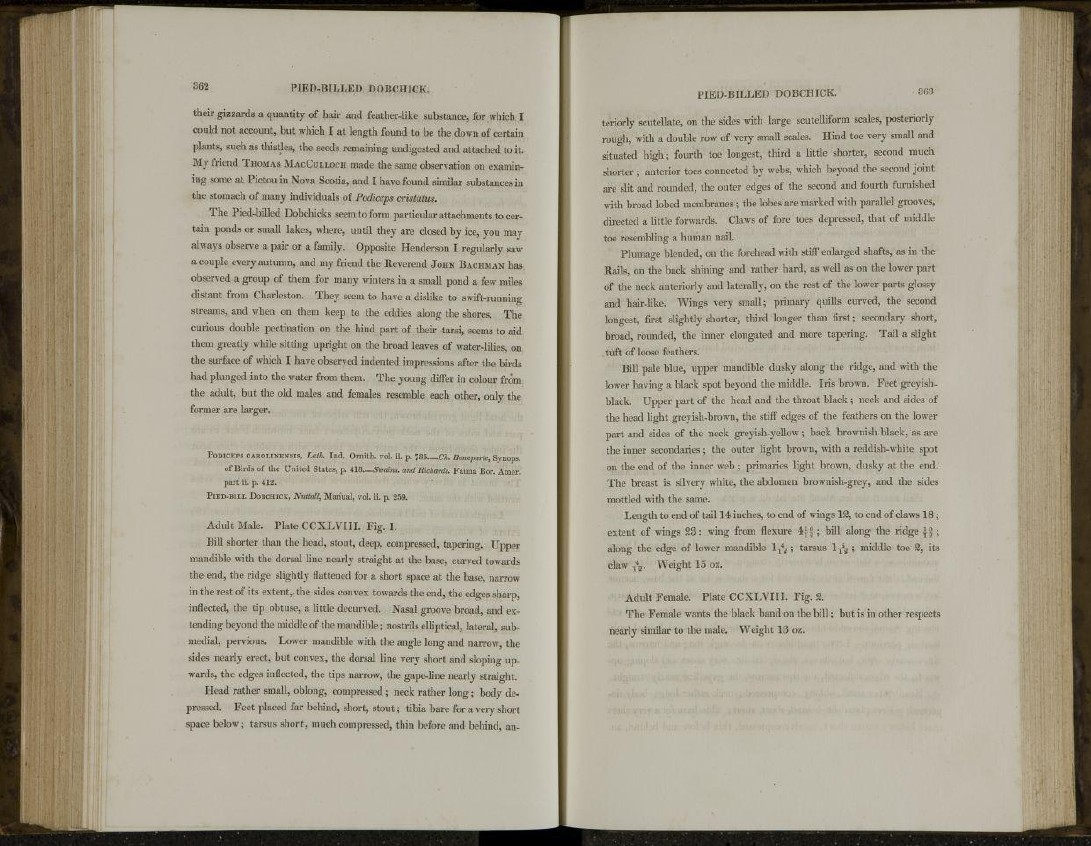
362 PIED-BILLED DOBCHICK.
their gizzards a quantity of hair and feather-like substance, for which I
could not account, but which I at length found to be the down of certain
plants, such as thistles, the seeds remaining undigested and attached to it.
My friend THOMAS MACCULLOCH made the same observation on examining
some at Pictou in Nova Scotia, and I have found similar substances in
the stomach of many individuals of Podiccps cristatus.
The Pied-billed Dobchicks seem to form particular attachments to certain
ponds or small lakes, where, until they are closed by ice, you may
always observe a pair or a family. Opposite Henderson I regularly saw
a couple every autumn, and my friend the Reverend JOHN BACHMAN has
observed a group of them for many winters in a small pond a few miles
distant from Charleston. They seem to have a dislike to swift-running
streams, and when on them keep to the eddies along the shores. The
curious double pectination on the hind part of their tarsi, seems to aid
them greatly while sitting upright on the broad leaves of water-lilies, on
the surface of which I have observed indented impressions after the birds
had plunged into the water from them. The young differ in colour from
the adult, but the old males and females resemble each other, only the
former are larger.
PODICEPS CAROLINENSIS, Lath. Ind. Ornith. vol. ii. p. 785—Ch. Bonaparte, Synops.
of Birds of the United States, p. 418.—Swains, and Bichards. Fauna Bor. Amer.
part ii. p. 412.
PIED-BILE DOBCHICK, Nuttall, Manual, vol. ii. p. 259.
Adult Male. Plate CCXLVIII. Fig. 1.
Bill shorter than the head, stout, deep, compressed, tapering. Upper
mandible with the dorsal line nearly straight at the base, curved towards
the end, the ridge slightly flattened for a short space at the base, narrow
in the rest of its extent,-the sides convex towards the end, the edges sharp,
inflected, the tip obtuse, a little decurved. Nasal groove broad, and extending
beyond the middle of the mandible; nostrils elliptical, lateral, submedial,
pervious. Lower mandible with the angle long and narrow, the
sides nearly erect, but convex, the dorsal line very short and sloping upwards,
the edges inflected, the tips narrow, the gape-line nearly straight.
Head rather small, oblong, compressed; neck rather long ; body depressed.
Feet placed far behind, short, stout; tibia bare for a very short
space below; tarsus short, much compressed, thin before and behind, an-
PIED-BILLED DOBCHICK. 363
teriorly scutellate, on the sides with large scutelliform scales, posteriorly
rough, with a double row of very small scales. Hind toe very small and
situated high; fourth toe longest, third a little shorter, second much
shorter ; anterior toes connected by webs, which beyond the second joint
are slit and rounded, the outer edges of the second and fourth furnished
with broad lobed membranes; the lobes are marked with parallel grooves,
directed a little forwards. Claws of fore toes depressed, that of middle
toe resembling a human nail.
Plumage blended, on the forehead with stiff enlarged shafts, as in the
Rails, on the back shining and rather hard, as well as on the lower part
of the neck anteriorly and laterally, on the rest of the lower parts glossy
and hair-like. Wings very small; primary quills curved, the second
longest, first slightly shorter, third longer than first; secondary short,
broad, rounded, the inner elongated and more tapering. Tail a slight
tuft of loose feathers.
Bill pale blue, upper mandible dusky along the ridge, and with the
lower having a black spot beyond the middle. Iris brown. Feet greyishblack.
Upper part of the head and the throat black ; neck and sides of
the head light greyish-brown, the stiff edges of the feathers on the lower
part and sides of the neck greyish-yellow; back brownish-black, as are
the inner secondaries; the outer light brown, with a reddish-white spot
on the end of the inner web; primaries light brown, dusky at the end.
The breast is silvery white, the abdomen brownish-grey, and the sides
mottled with the same.
Length to end of tail 14 inches, to end of wings 12, to end of claws 18;
extent of wings 23: wing from flexure 4[g; bill along the ridge ;
along the edge of lower mandible lj*2 ; tarsus 1/j ; middle toe 2, its
claw Weight 15 oz.
Adult Female. Plate CCXLVIII. Fig. 2.
The Female wants the black band on the bill; but is in other respects
nearly similar to the male. Weight 13 oz.